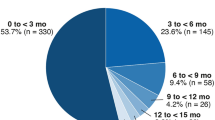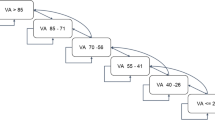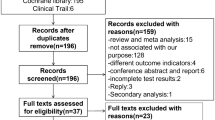Abstract
Background
Vascular endothelial growth factor (VEGF) plays an important role in many diseases of the posterior pole that are characterized by macular edema and/or intraocular neovascularization. Recently anti-VEGF agents such as ranibizumab and pegaptanib sodium have been shown to be beneficial in the treatment of choroidal neovascularization (CNV) secondary to age-related macular degeneration (ARMD). However in most parts of the world, both pegaptanib sodium and ranibizumab are not readily available. Bevacizumab, a humanized recombinant monoclonal IgG antibody that binds and inhibits all VEGF isoforms, has been proposed as an alternative treatment option.
Methods
A total of 1,265 consecutive patients were injected with bevacizumab for diseases such as proliferative diabetic retinopathy, diabetic macular edema, retinal vein occlusions, and CNV of several etiologies including ARMD at eight Latin American institutions from 1 September 2005 to 31 January 2006. Of these 1,265, 92 were excluded because they were injected once and lost to follow-up. The remaining 1,173 patients constitute the subjects of this retrospective, multicenter, open label, uncontrolled interventional case series that reports the cumulative systemic and ocular adverse events following intravitreal bevacizumab during 12 months of follow-up. Patients were examined at baseline and then monthly. If the patients were unable to attend the 12-month visit, a telephone interview was conducted to assess for possible systemic complications.
Results
A total of 4,303 intravitreal injections of bevacizumab on 1,310 eyes was reported. All 1,173 patients were accounted for at the 12-month visit. Systemic adverse events were reported in 18 (1.5%) patients. These included seven (0.59%) cases of an acute elevation of systemic blood pressure, six (0.5%) cerebrovascular accidents, five (0.4%) myocardial infarctions, two (0.17%) iliac artery aneurysms, two (0.17%) toe amputations and five (0.4%) deaths. Ocular complications included seven (0.16%) bacterial endophthalmitis, seven (0.16%) tractional retinal detachments, four (0.09%) uveitis, and a case (0.02%) each of rhegmatogenous retinal detachment and vitreous hemorrhage.
Conclusion
Despite the limited follow-up, repeated intravitreal injections of either 1.25 mg or 2.5 mg of bevacizumab appears to be safe and well tolerated during the 1st year.
Similar content being viewed by others
References
Adamis AP, Aiello LP, D’Amato RA (1999) Angiogenesis and ophthalmic disease. Angiogenesis 3:9–14
Adamis AP, Shima DT (2005) The role of vascular endothelial growth factor in ocular health and disease. Retina 25:111–118
Qaum T, Xu Q, Joussen AM, et al (2001) VEGF-initiated blood-retinal barrier breakdown in early diabetes. Invest Ophthalmol Vis Sci 42:2408–2413
Saishin Y, Saishin Y, Takahashi K, et al (2003) VEGF-TRAP(R1R2) suppresses choroidal neovascularization and VEGF-induced breakdown of the blood-retinal barrier. J Cell Physiol 195:241–248
Cunningham ET Jr, Adamis AP, Altaweel M, et al (2005) A phase II randomized double-masked trial of pegaptanib, an anti-vascular endothelial growth factor aptamer, for diabetic macular edema. Ophthalmology 112:1747–1757
Gragoudas ES, Adamis AP, Cunningham ET Jr, et al (2004) Pegaptanib for neovascular age-related macular degeneration. N Engl J Med 351:2805–2816
Heier JS, Antoszyk AN, Pavan PR, et al (2006) Ranibizumab for treatment of neovascular age-related macular degeneration: a phase I/II multicenter, controlled, multidose study. Ophthalmology 113(642):e1–e4
Hurwitz H, Fehrenbacher L, Novotny W, et al (2004) Bevacizumab plus irinotecan, fluorouracil, and leucovorin for metastatic colorectal cancer. N Engl J Med 350:2335–2342
Michels S, Rosenfeld PJ, Puliafito CA, et al (2005) Systemic bevacizumab (Avastin) therapy for neovascular age-related macular degeneration twelve-week results of an uncontrolled open-label clinical study. Ophthalmology 112:1035–1047
Rosenfeld PJ, Fung AE, Puliafito CA (2005) Optical coherence tomography findings after an intravitreal injection of bevacizumab (avastin) for macular edema from central retinal vein occlusion. Ophthalmic Surg Lasers Imaging 36:336–339
Rosenfeld PJ, Moshfeghi AA, Puliafito CA (2005) Optical coherence tomography findings after an intravitreal injection of bevacizumab (Avastin) for neovascular age-related macular degeneration. Ophthalmic Surg Lasers Imaging 36:331–335
Aiello LP, Brucker AJ, Chang S, et al (2004) Evolving guidelines for intravitreous injections. Retina 24:S3–19
Drolet DW, Nelson J, Tucker CE, et al (2000) Pharmacokinetics and safety of an anti-vascular endothelial growth factor aptamer (NX1838) following injection into the vitreous humor of rhesus monkeys. Pharm Res 17:1503–1510
Gaudreault J, Fei D, Rusit J, et al (2005) Preclinical pharmacokinetics of Ranibizumab (rhuFabV2) after a single intravitreal administration. Invest Ophthalmol Vis Sci 46:726–733
van Wijngaarden P, Coster DJ, Williams KA (2005) Inhibitors of ocular neovascularization: promises and potential problems. JAMA 293:1509–1513
Sane DC, Anton L, Brosnihan KB (2004) Angiogenic growth factors and hypertension. Angiogenesis 7:193–201
Kernt M, Neubauer AS, Kampik A (2007) Intravitreal bevacizumab (Avastin) treatment is safe in terms of intraocular and blood pressure. Acta Ophthalmol Scand 85:119–120
Ratner M (2004) Genentech discloses safety concerns over Avastin. Nat Biotechnol 22:1198
Fung AE, Rosenfeld PJ, Reichel E (2006) The international intravitreal bevacizumab safety survey: using the internet to assess drug safety worldwide. Br J Ophthalmol 90:1344–1349
Spaide RF, Laud K, Fine HF, et al (2006) Intravitreal bevacizumab treatment of choroidal neovascularization secondary to age-related macular degeneration. Retina 26:383–390
Avery RL, Pieramici DJ, Rabena MD, et al (2006) Intravitreal bevacizumab (Avastin) for neovascular age-related macular degeneration. Ophthalmology 113(3):363–372 e5
(2001) Photodynamic therapy of subfoveal choroidal neovascularization in age-related macular degeneration with verteporfin: two-year results of 2 randomized clinical trials-tap report 2. Arch Ophthalmol 119:198–207
(2001)Verteporfin therapy of subfoveal choroidal neovascularization in age-related macular degeneration: two-year results of a randomized clinical trial including lesions with occult with no classic choroidal neovascularization-verteporfin in photodynamic therapy report 2. Am J Ophthalmol 131:541–560
Slakter JS, Bochow TW, D’Amico DJ, et al (2006)Anecortave acetate (15 milligrams) versus photodynamic therapy for treatment of subfoveal neovascularization in age-related macular degeneration. Ophthalmology 11:3–13
Rosenfeld PJ, Rich RM, Lalwani GA (2006) Ranibizumab: phase III clinical trial results. Ophthalmol Clin North Am 19:361–372
Geiss LS, Herman WH, PJS (2007) Mortality in Non-Insulin Dependent Diabetes. Diabetes in America, 2nd Ed. http://diabetes.niddk.nih.gov/dm/pubs/america/pdf/chapter11.pdf. Accessed February 14
Manzano RP, Peyman GA, Khan P, Kivilcim M (2006) Testing intravitreal toxicity of bevacizumab (Avastin). Retina 26:257–261
Shahar J, Avery RL, Heilweil G, et al (2006) Electrophysiologic and retinal penetration studies following intravitreal injection of bevacizumab (Avastin). Retina 26:262–269
Maturi RK, Bleau LA, Wilson DL (2006) Electrophysiologic findings after intravitreal bevacizumab (Avastin) treatment. Retina 26:270–274
Luthra S, Narayanan R, Marques LE, et al (2006) Evaluation of in vitro effects of bevacizumab (avastin) on retinal pigment epithelial, neurosensory retinal, and microvascular endothelial cells. Retina 26:512–518
Luke M, Warga M, Ziemssen F, et al (2006) Effects of bevacizumab on retinal function in isolated vertebrate retina. Br J Ophthalmol 90:1178–1182
Jager RD, Aiello LP, Patel SC, Cunningham ET Jr (2004) Risks of intravitreous injection: a comprehensive review. Retina 24:676–698
Ziemssen F, Warga M, Neuhann IM, et al (2006) Does intravitreal injection of bevacizumab have an effect on the blood-aqueus barrier function? Br J Ophthalmol 90:922
Author information
Authors and Affiliations
Consortia
Corresponding author
Additional information
For a complete listing of participating members of PACORES see the Appendix.
The authors have no financial interests in the subject matter presented.
Appendix
Appendix
The following investigators belong to the Pan-American Collaborative Retina Study Group (PACORES):
The Pan-American Collaborative Retina Study Group (PACORES)*
L. Wu (PI), T. Evans, Instituto de Cirugia Ocular, San Jose, Costa Rica; J.F. Arevalo (PI), J.G. Sanchez, R.A. Garcia-Amaris, Clinica Oftalmologica Centro Caracas and the Arevalo-Coutinho Foundation for Research in Ophthalmology, Caracas, Venezuela; M. Farah (PI), M. Maia, F.B. Aggio, Universidade Federal de São Paulo-Departamento de Oftalmologia-Instituto da Visão-Sao Paulo, Brazil; H. Quiroz-Mercado (PI), J. Fromow-Guerra, V. Morales-Canton, J. Dalma-Weiszhausz, Asociación para Evitar la Ceguera en México, Mexico City, Mexico; F.J. Rodriguez (PI), R. Infante, S. Flores, D. Medina, Fundacion Oftalmologica Nacional, Universidad del Rosario, Bogota, Colombia; M.H. Berrocal (PI), V. Cruz-Villegas, University of Puerto Rico, San Juan, Puerto Rico; F. Graue-Wiechers (PI), D. Lozano-Rechy, V. Robledo, Fundacion Conde Valenciana, Mexico City, Mexico; J.A. Roca (PI), G. Reategui, Clínica Ricardo Palma, Lima, Peru; M. J. Saravia (PI), M. Martinez-Cartier, Hospital Universitario Austral, Buenos Aires, Argentina; M. Avila (PI), Universidade Federal de Goiás-Departamento de Oftalmologia-Goiânia, Brazil; RA Costa (PI), J. Cardillo, Hospital de Olhos de Araraquara, and the Universidade de Sao Paulo, Sao Paulo, Brazil.
*PI = principal investigator.
Rights and permissions
About this article
Cite this article
Wu, L., Martínez-Castellanos, M.A., Quiroz-Mercado, H. et al. Twelve-month safety of intravitreal injections of bevacizumab (Avastin®): results of the Pan-American Collaborative Retina Study Group (PACORES). Graefes Arch Clin Exp Ophthalmol 246, 81–87 (2008). https://doi.org/10.1007/s00417-007-0660-z
Received:
Revised:
Accepted:
Published:
Issue Date:
DOI: https://doi.org/10.1007/s00417-007-0660-z




